Analysis of Thermodynamic Events Taking Place during Vacuum Drying of Corn
Abstract
:1. Introduction
2. Material and Methods
Vacuum Drying of Corn under Laboratory Conditions
- Preparation of a corn sample;
- Heating of the corn sample in a vacuum chamber;
- Evaporation of water from corn kernels in the vacuum chamber;
- Drying of the corn sample on a sieve.
- tc—temperature of the corn sample;
- tg—temperature of the selected corn grain;
- th—temperature of the electrically heated coils;
- t—temperature of moist air in the vacuum chamber;
- p—pressure of moist air in the vacuum chamber.
- mc1—at the beginning of the measurement;
- mc2—after removing the sample from the vacuum chamber;
- mc3—after drying the sample on the sieve.
- Pressure p1 in the vacuum chamber during the heating of a corn sample;
- Pressure p2 in the vacuum chamber during the evaporation of water from the corn sample;
- Changes in the temperature tc2 of the corn sample due to the regulation of the power input by the coils during the evaporation of water from the corn sample;
- Time τ2 of heating during the evaporation of water from the corn sample;
- Number of cycles of evaporation of water from the corn sample to reduce moisture.
- wc1 = 10.487% for measurements no. 1 to no. 9 carried out in February 2022;
- wc1 = 8.858% for measurements no. 10 to no. 14 carried out in April 2022.
- The difference in the corn moisture content wc1 at the beginning of the measurement and wc3 after drying the sample on the sieve:
- The relative moisture difference of the corn sample as defined by the proportion of the difference and the moisture content of the corn sample wc1 at the beginning of the measurement:
3. Results
3.1. Effect of Vacuum Chamber Pressure on Reduction in Moisture during Heating of Corn Sample
3.2. Effect of Vacuum Chamber Pressure on Reduction in Moisture during Evaporation of Water from Corn Sample
3.3. Effect of Heating Time on Reduction in Moisture during Evaporation of Water from Corn Sample
- During measurement no. 13 after a heating time τ2 of 0:42 h of vacuum drying, the moisture content decreased to a value of wc3 = 8.492%, which corresponded to a moisture difference of 0.366%, and relative moisture difference = 4.132%;
- During measurement no. 14 after a heating time τ2 of 0:58 h of vacuum drying, the moisture content decreased to a value of wc3 = 8.485%, which corresponded to a moisture difference of 0.373%, and relative moisture difference = 4.212%.
3.4. Effect of Number of Cycles of Water Evaporation on Reduction in Moisture
4. Discussion
4.1. Effect of Vacuum Chamber Pressure on Reduction in Moisture during Heating of Corn Sample
4.2. Effect of Vacuum Chamber Pressure on Reduction in Moisture during Evaporation of Water from Corn Sample
4.3. Effect of Controlling the Power Input of Coils on Reduction in Moisture during the Evaporation of Water from Corn Kernels
4.4. Effect of Heating Time on Reduction in Moisture during Evaporation of Water from Corn Sample
4.5. Effect of Number of Cycles of Water Evaporation on Reduction in Corn Moisture
5. Conclusions
- Heat the corn sample at a higher pressure value in the vacuum chamber using better heat transfer for more intense heat convection;
- Carry out the drying phase in the pressure range of 9–10 kPa, and, when drying at a lower pressure, a higher moisture content of corn is achieved;
- Continuously heat the corn sample during the entire drying phase so that the temperature of the corn sample changes minimally;
- Choose a heating time in the range of 40–45 min and a heating intensity corresponding to the rate of heat transfer in the given environment;
- Due to the dynamics of the drying process, it is advantageous to carry out the drying process with a low intensity over several cycles.
Author Contributions
Funding
Institutional Review Board Statement
Informed Consent Statement
Data Availability Statement
Conflicts of Interest
References
- Liu, Z.; Wu, Z.; Zhang, Z.; Wu, W.; Li, H. Research on online moisture detector in grain drying process based on V/F conversion. Math. Probl. Eng. 2015, 2015, 565764. [Google Scholar] [CrossRef]
- Ertekin, C.; Firat, M.Z. A comprehensive review of thin-layer drying models used in agricultural products. Crit. Rev. Food Sci. Nutr. 2017, 57, 701–717. [Google Scholar] [CrossRef] [PubMed]
- Ali, M.; Niazi, F.; Ali Siddiqui, M.; Saleem, M. Comparative Study on Oven and Solar Drying of Agricultural Residues and Food Crops. Int. J. Renew. Energy Dev. 2022, 11, 1165–1178. [Google Scholar] [CrossRef]
- Rogovskii, I.L.; Titova, L.; Trokhaniak, V.I.; Solomka, O.V.; Popyk, P.S.; Shvidia, V.O.; Степаненкo, C. Experimental studies on drying conditions of grain crops with high moisture content in low-pressure environment. INMATEH-Agric. Eng. 2019, 57, 141–146. [Google Scholar] [CrossRef] [PubMed]
- Tagawa, A.; Muramatsu, Y.; Nagasuna, T.; Yano, A.; Iimoto, M.; Murata, S. Water absorption characteristics of wheat and barley during soaking. Trans. ASAE 2013, 46, 361–366. [Google Scholar] [CrossRef]
- Wang, J.; Law, C.-L.; Nema, P.K.; Zhao, J.-H.; Liu, Z.-L.; Deng, L.-Z.; Gao, Z.-J.; Xiao, H.-W. Pulsed vacuum drying enhances drying kinetics and quality of lemon slices. J. Food Eng. 2018, 224, 129–138. [Google Scholar] [CrossRef]
- Ibn Maamar, M.; Badraoui, M.; Mazouzi, M.; Mouakkir, L. Mathematical Modeling on Vacuum Drying of Olive Pomace. Trends Sci. 2022, 20, 3822. [Google Scholar] [CrossRef]
- Wu, L.; Orikasa, T.; Ogawa, Y.; Tagawa, A. Vacuum drying characteristics of eggplants. J. Food Eng. 2007, 83, 422–429. [Google Scholar] [CrossRef]
- Yu, S.; Yang, X.; Li, Q.; Zhang, Y.; Zhou, H. Breaking the temperature limit of hydrothermal carbonization of lignocellulosic biomass by decoupling temperature and pressure. Green Energy Environ. 2023, 8, 1216–1227. [Google Scholar] [CrossRef]
- da Silva Timm, N.; Coradi, P.C.; Dos Santos Bilhalva, N.; Nunes, C.F.; da Costa Corrêa Cañizares, L. Effects of corn drying and storage conditions on flour, starch, feed, and ethanol production: A review. J. Food Sci. Technol. 2023, 60, 2337–2349. [Google Scholar] [CrossRef]
- Wang, J.; Dai, J.W.; Yang, S.L.; Wen, M.D.; Fu, Q.Q.; Huang, H.; Qin, W.; Li, Y.L.; Lin, Y.W.; Yin, P.F.; et al. Influence of pulsed vacuum drying on drying kinetics and nutritional value of corn kernels. J. Food Process. Eng. 2020, 43, e13550. [Google Scholar] [CrossRef]
- Liu, Z.; Wu, Z.; Wang, X.; Song, J.; Wu, W. Numerical Simulation and Experimental Study of Deep Bed Corn Drying Based on Water Potential, Special Issure, Modeling, Optimization, and Verification for Complex Systems. Math. Probl. Eng. 2015, 2015, 539846. [Google Scholar] [CrossRef]
- Bazyma, L.A.; Guskov, V.P.; Basteev, A.V.; Lyashenko, A.M.; Lyakhno, V.; Kutovoy, V.A. The investigation of low temperature vacuum drying processes of agricultural materials. J. Food Eng. 2006, 74, 410–415. [Google Scholar] [CrossRef]
- Sheng, S.; Ši, A.; Xing, J. A Systematic Rheological Study of Maize Kernel. Foods 2023, 12, 738. [Google Scholar] [CrossRef] [PubMed]
- Rao, K.R.; Ram Prasanth, M.G.; Sangeetha, M. Review on Multi Grain Dryer. Int. J. Res. Eng. Sci. 2022, 10, 464–469. [Google Scholar]
- Song, J.; Li, D.; He, M.; Chen, J.; Liu, C. Comparison of carotenoid composition in immature and mature grains of corn (Zea mays L.) varieties. Int. J. Food Prop. 2016, 19, 351–358. [Google Scholar] [CrossRef]
- Ferraretto, L.F.; Taysom, K.; Taysom, D.M.; Shaver, R.D.; Hoffman, P.C. Relationships between dry matter content, ensilage, ammonia-nitrogen, and in vitro rumen starch digestibility in high-moisture corn samples. J. Dairy Sci. 2014, 97, 3221–3227. [Google Scholar] [CrossRef]
- Parvej, M.D.; Rasel, C.R.; Hanna, H.M.; Licht, M.A. Dynamics of corn dry matter content and grain quality after physiological maturity. Agron. J. 2020, 112, 998–1011. [Google Scholar] [CrossRef]
- Sadjad, A.; Saeid, M. Effect of drying temperature on the mechanical properties of dried corn. Dry. Technol. Int. J. 2013, 32, 774–780. [Google Scholar] [CrossRef]
- Barrier-Guillot, B.; Zuprizal; Jondreville, C.; Chagneau, A.M.; Larbier, M.; Leuillet, M. Effect of thermal drying temperature on the nutritional value of corn in chickens and pigs. Anim. Feed. Sci. Technol. 1993, 41, 149–159. [Google Scholar] [CrossRef]
- Li, Q.; Shi, M.; Shi, C.; Liu, D.; Piao, X.; Li, D.; Lai, C. Effect of variety and drying method on the nutritional value of corn for growing pigs. J. Anim. Sci. Biotechnol. 2014, 5, 18. [Google Scholar] [CrossRef]
- Liu, H.; Liu, H.; Liu, H.; Zhang, X.; Hong, Q.; Chen, W.; Zeng, X. Microwave drying characteristics and analysis of corn drying quality in China. Processes 2021, 9, 1511. [Google Scholar] [CrossRef]
- Applegate, T.J.; Troche, C.; Jiang, Z.; Johnson, T. Nutritional value of high-protein corn distillers dried grains for broiler chickens and its effect on nutrient excretion. Poult. Sci. 2009, 88, 354–359. [Google Scholar] [CrossRef] [PubMed]
- Ononogbo, C.; Nwufo, O.C.; Nwakuba, N.R.; Okoronkwo, C.A.; Igbokwe, J.O.; Nwadinobi, P.C.; Anyanwu, E.E. Energy parameters of corn drying in a hot air dryer powered by exhaust gas waste heat: An optimization case study of the food-energy nexus. Energy Nexus 2021, 4, 100029. [Google Scholar] [CrossRef]
- Onwude, D.I.; Hashim, N.; Chen, G. Recent advances of novel thermal combined hot air drying of agricultural crops. Trends Food Sci. Technol. 2016, 57, 132–145. [Google Scholar] [CrossRef]
- Wang, H.; Torki, M.; Taherian, A.; Beigi, M.; Xiao, H.-M.; Fang, H.-M. Analysis of exergetic performance for a combined ultrasonic power/convective hot air dryer. Renew. Sustain. Energy Rev. 2023, 185, 113607. [Google Scholar] [CrossRef]
- Parikh, D.M. Vacuum drying: Fundamentals and application. Chem. Eng. 2015, 122, 48–54. [Google Scholar]
- Bao, X.; Min, R.; Zhou, K.; Traffano-Schiffo, M.V.; Dong, Q.; Luo, W. Effects of vacuum drying assisted with condensation on drying characteristics and quality of apple slices. J. Food Eng. 2023, 340, 111286. [Google Scholar] [CrossRef]
- Yao, K.; Jiang, S.; Li, S.; Zhang, C.; Hou, H. Solvothermal imidization to polyimide composite aerogels by vacuum drying. Compos. Commun. 2023, 38, 101503. [Google Scholar] [CrossRef]
- Xu, J.; Sun, J.; Zhao, J.; Zhang, W.; Zhou, J.; Xu, L.; Guo, H.; Liu, Y.; Zhang, D. Eco-friendly wood plastic composites with biomass-activated carbon-based form-stable phase change material for building energy conversion. Ind. Crops Prod. 2023, 197, 116573. [Google Scholar] [CrossRef]
- da Silva, A.C.C.; Biz, A.P. Longhi, D.A.; Schmidt, F.C. Effect of concentration and temperature on the physical and thermophysical properties of coffee extract. J. Food Eng. 2023, 340, 111304. [Google Scholar] [CrossRef]
- Zhao, L.; Xie, H.; Liu, Y.; Ran, C.; Wu, Z. Heat and mass transfer in vacuum drying process of fructooligosaccharides syrup. Int. J. Food Eng. 2023, 19, 397–409. [Google Scholar] [CrossRef]
- Zang, Z.; Huang, X.; He, C.; Zhang, Q.; Jiang, C.; Wan, F. Improvement of the drying properties and physicochemical quality of Angelica sinensis by a novel microwave vacuum drying with tray rotation. Groc. Store 2023, 12, 1202. [Google Scholar] [CrossRef]
- Liu, Y.Y.; Liao, F.J.; Li, Y.S.; Chen, H.P.; Wang, F.; Hu, Y.; Liu, Y.P. Effects of different drying methods on the quality of male flowers of Eucommia ulmoides based on color and chemical composition. Zhongguo Zhong Yao Za Zhi Zhongguo Zhongyao Zazhi China J. Chin. Mater. Medica 2023, 48, 1876–1884. [Google Scholar] [CrossRef]
- Zhang, Y.; Zhu, H.; Wu, W.; Li, J.; Yin, L. Internal Stress Analysis on Corn Grain During Vacuum Drying, Source: Sensor Letters. Am. Sci. 2012, 10, 574–579. [Google Scholar] [CrossRef]
- Kalus, V. Analysis of Operational and Economic Indicators of a Gas Dryer of Agricultural Commodities. Diploma Thesis, Faculty of Agriculture Mendel University, Brno, Czech Republic, 2010. Available online: https://is.mendelu.cz/zp/index.pl?podrobnosti=36068 (accessed on 3 April 2023).
- Odjo, S.; Béra, F.; Beckers, Y.; Foucart, G.; Malumba, P. Influence of variety, harvesting date and drying temperature on the composition and the in vitro digestibility of corn grain. J. Cereal Sci. 2018, 79, 218–225. [Google Scholar] [CrossRef]
- Šooš, Ľ. Research on Thermal Processes in the Process of Reducing the Humidity of Organic Materials; Research Report for 2020; Project no. Window Glass, s.r.o.; Faculty of Mechanical Engineering, STU in Bratislava: Bratislava, Slovakia, 2021. [Google Scholar]
- Martynov, V.; Gabitov, I.; Karimov, K.; Masalimov, I.; Permyakov, V.; Ganeev, I.; Saitov, I.; Saitov, B. Reasoning Barley Grain Drying Modes for Vacuum-Infrared Drying Machines. J. Eng. Appl. Sci. 2018, 13, 8803–8811. [Google Scholar] [CrossRef]
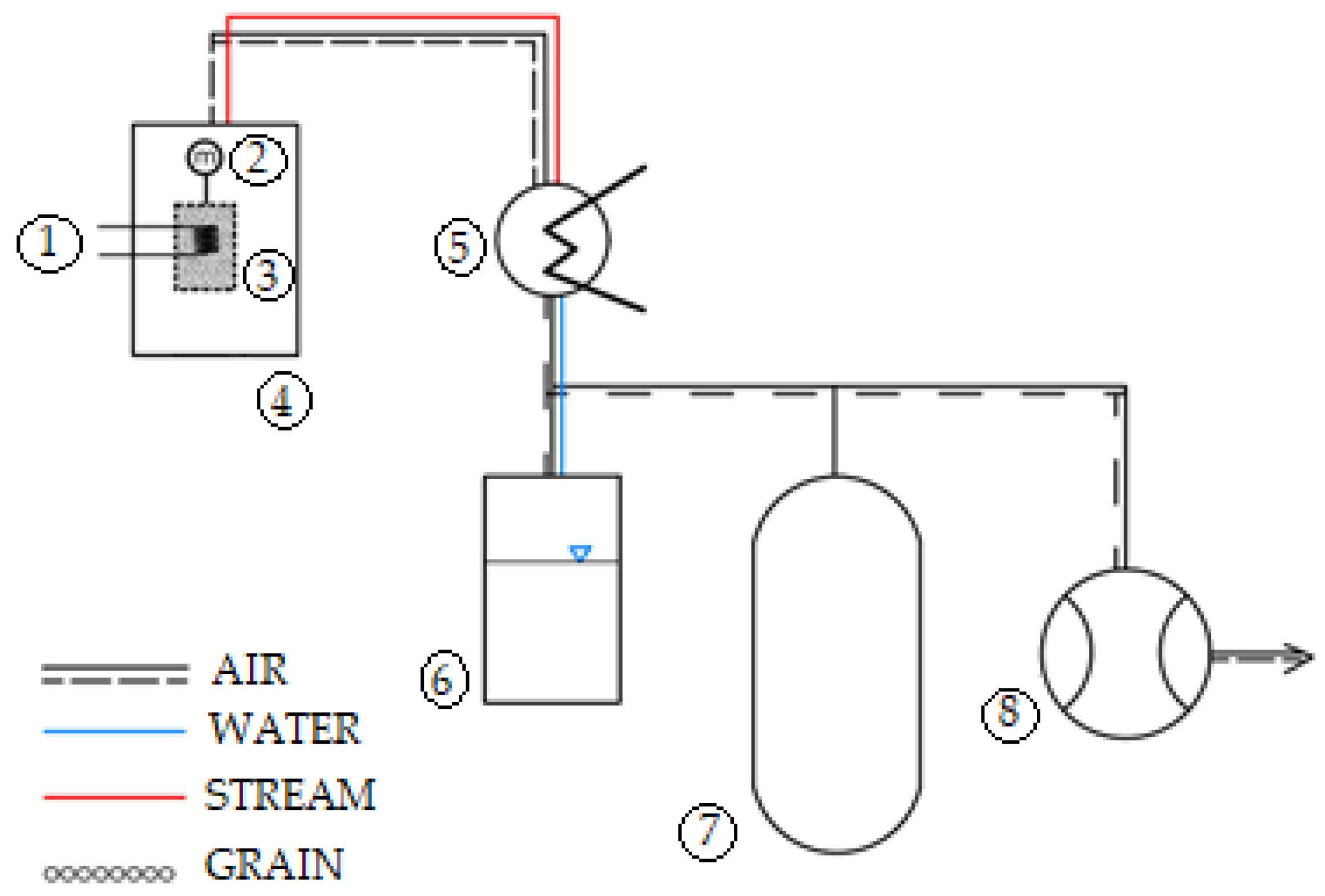
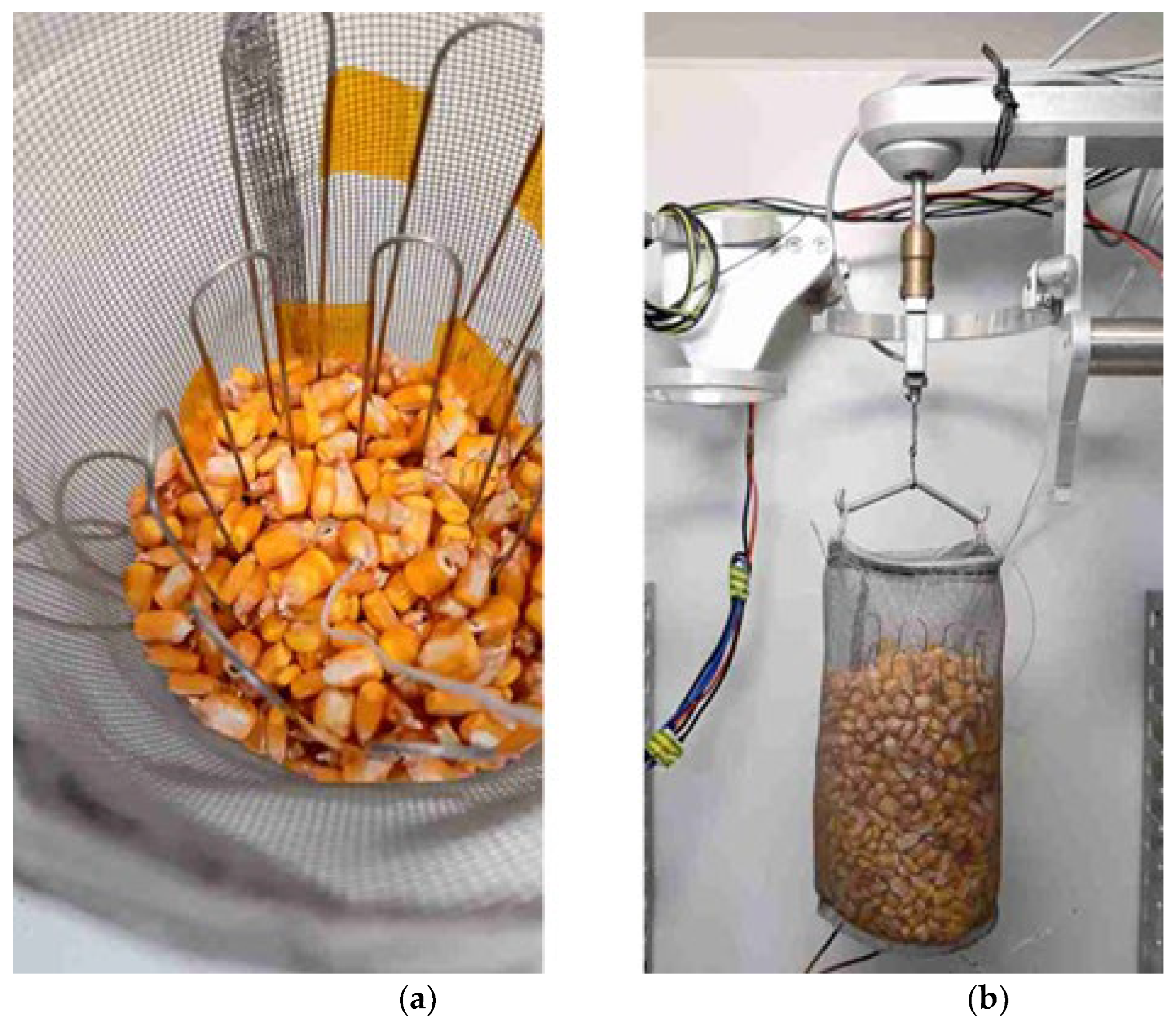



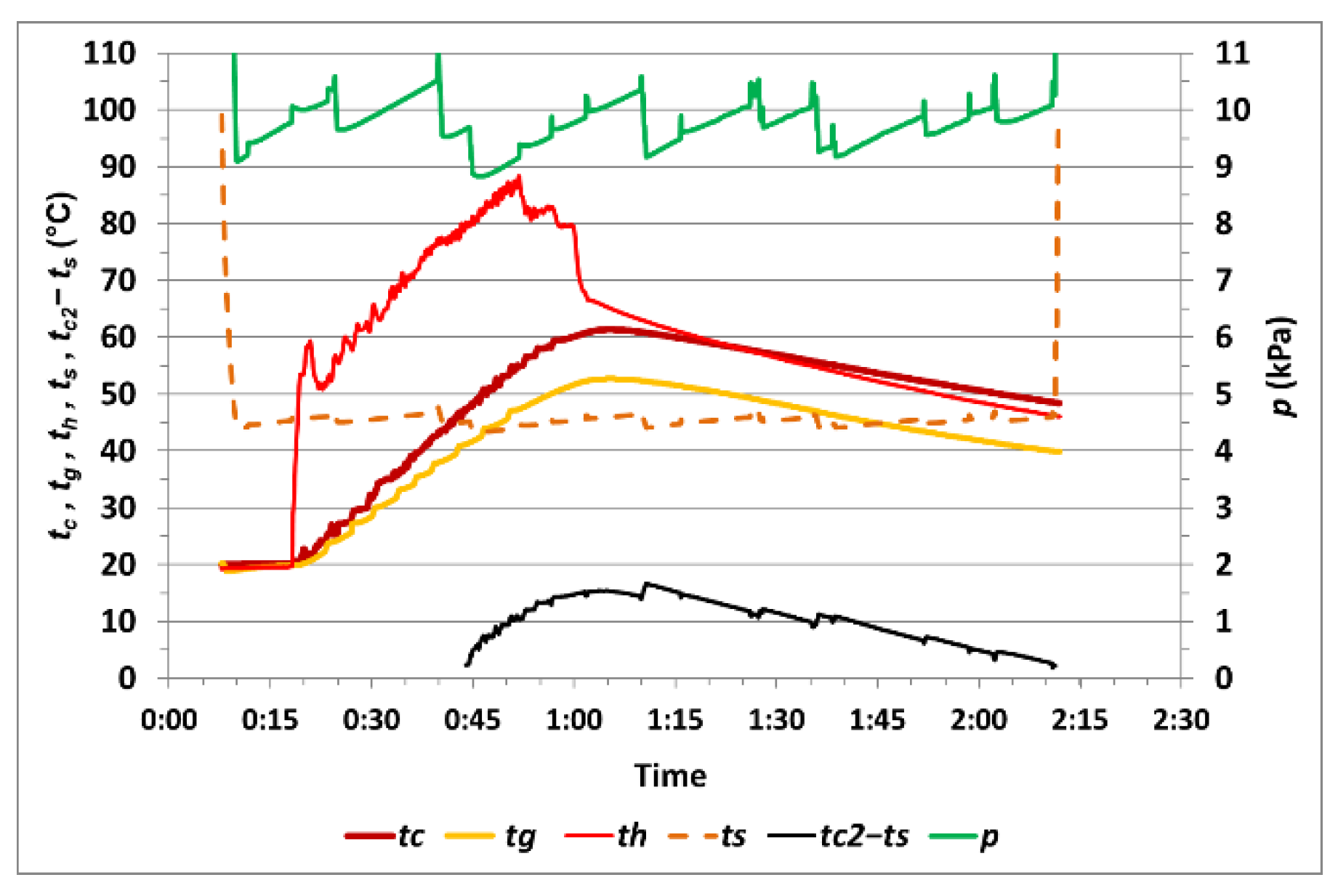
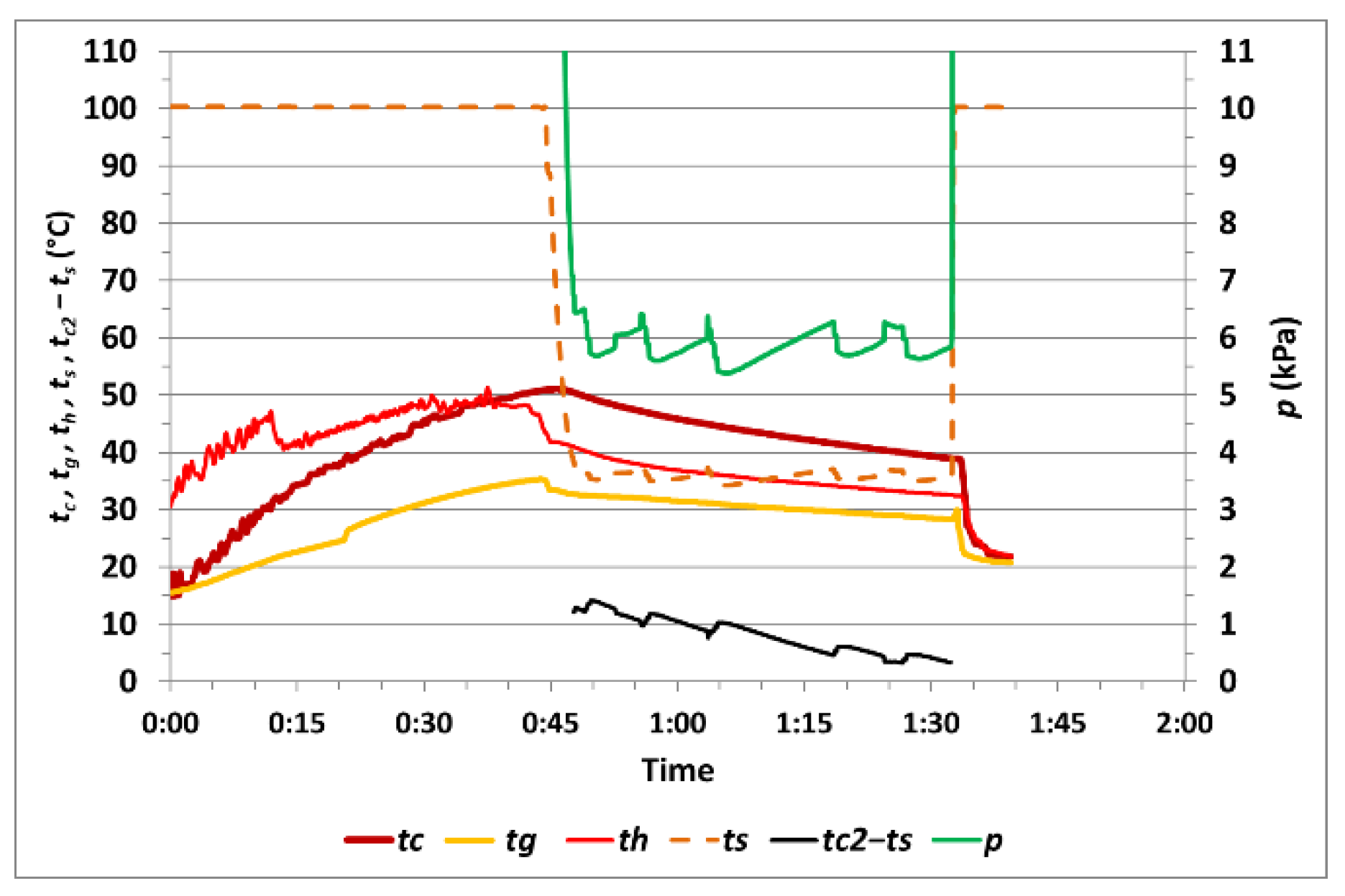
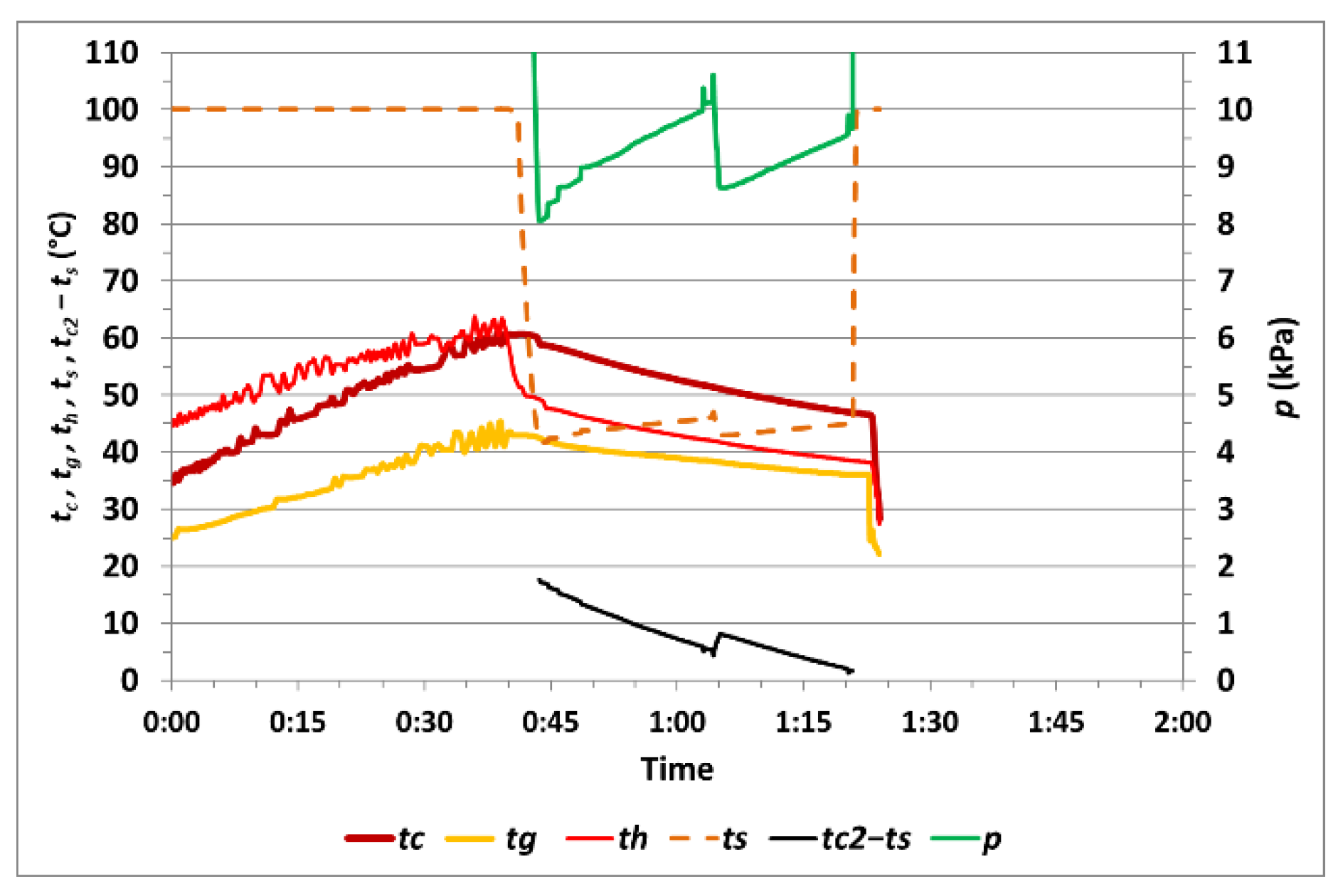

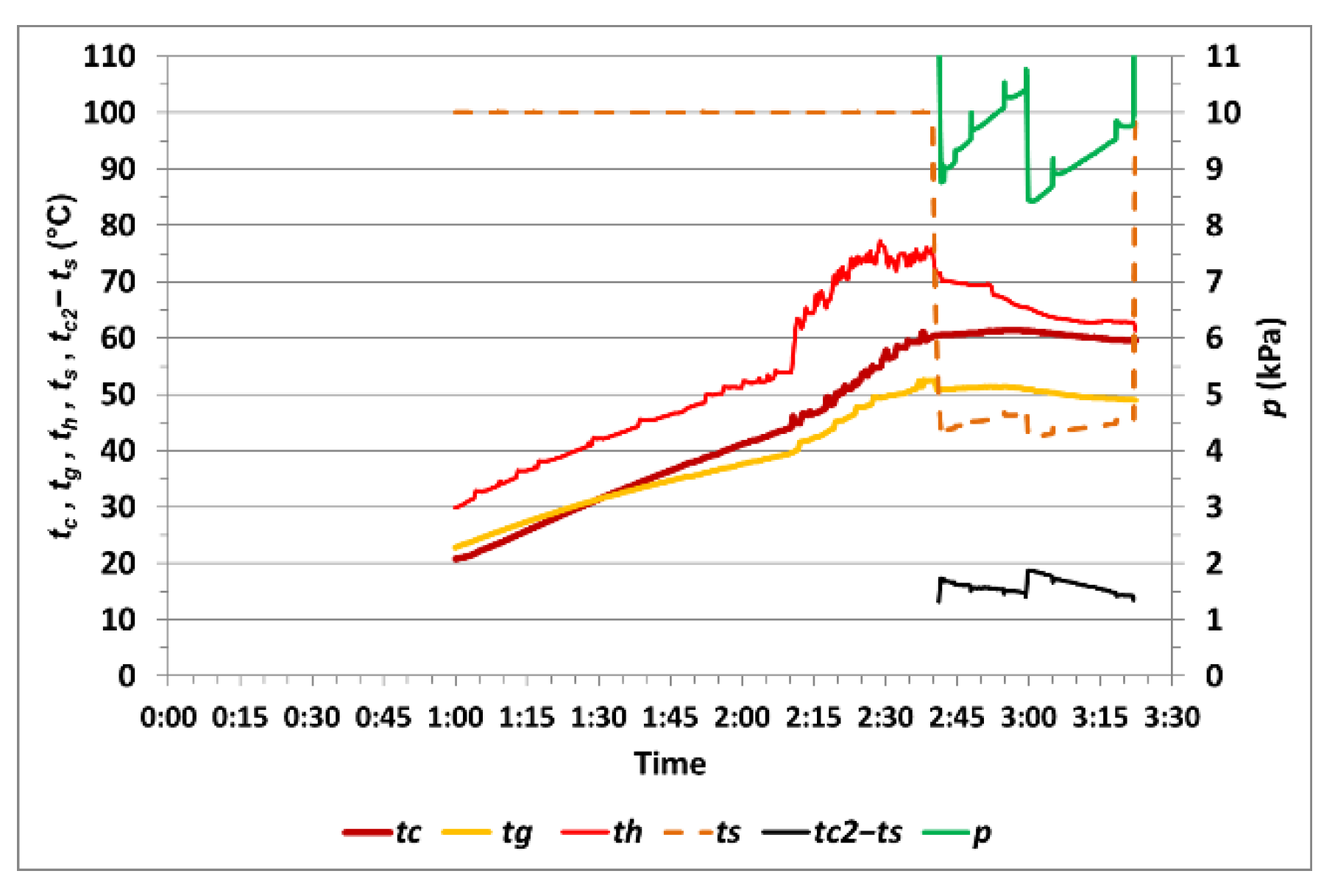
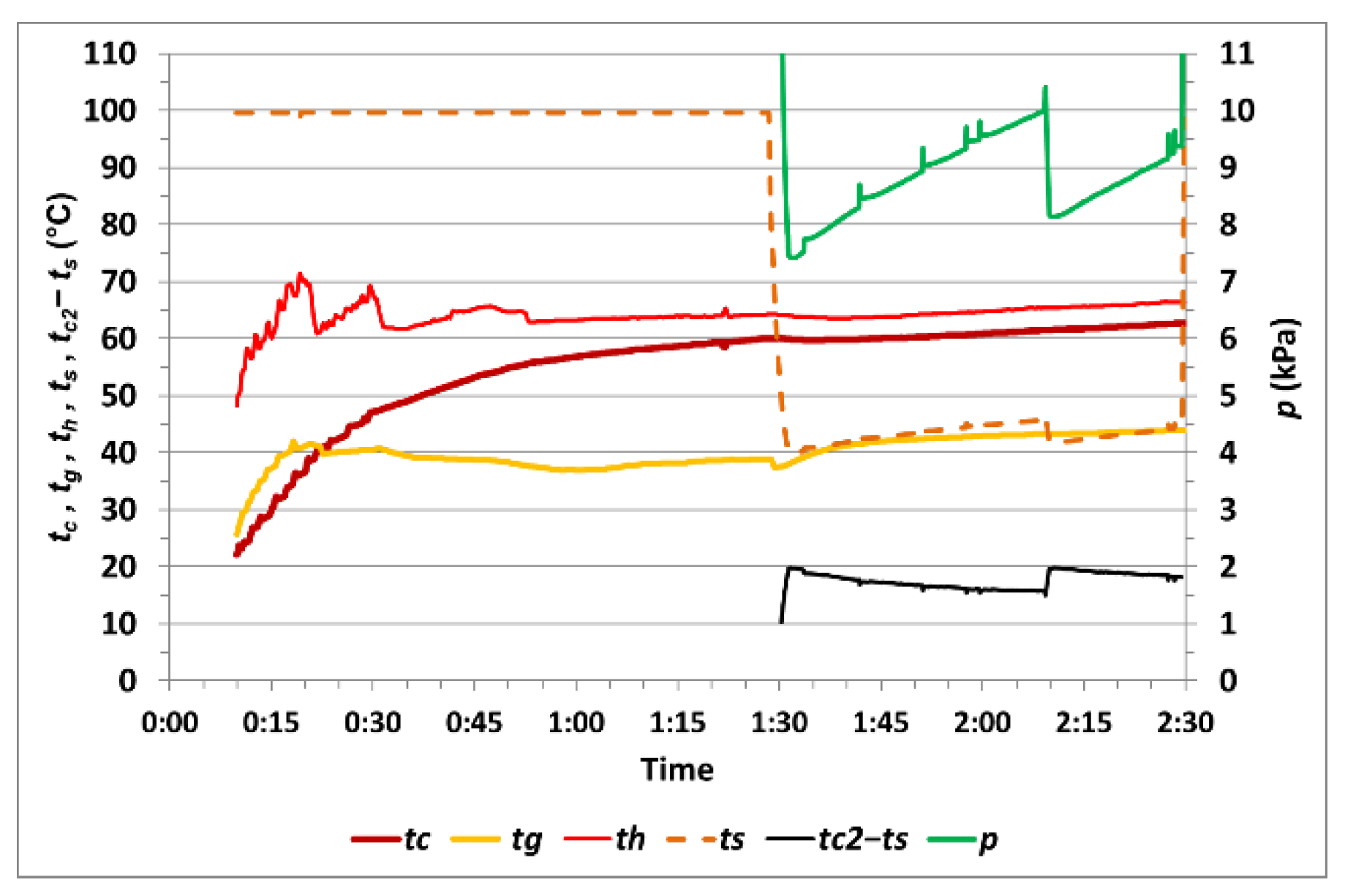
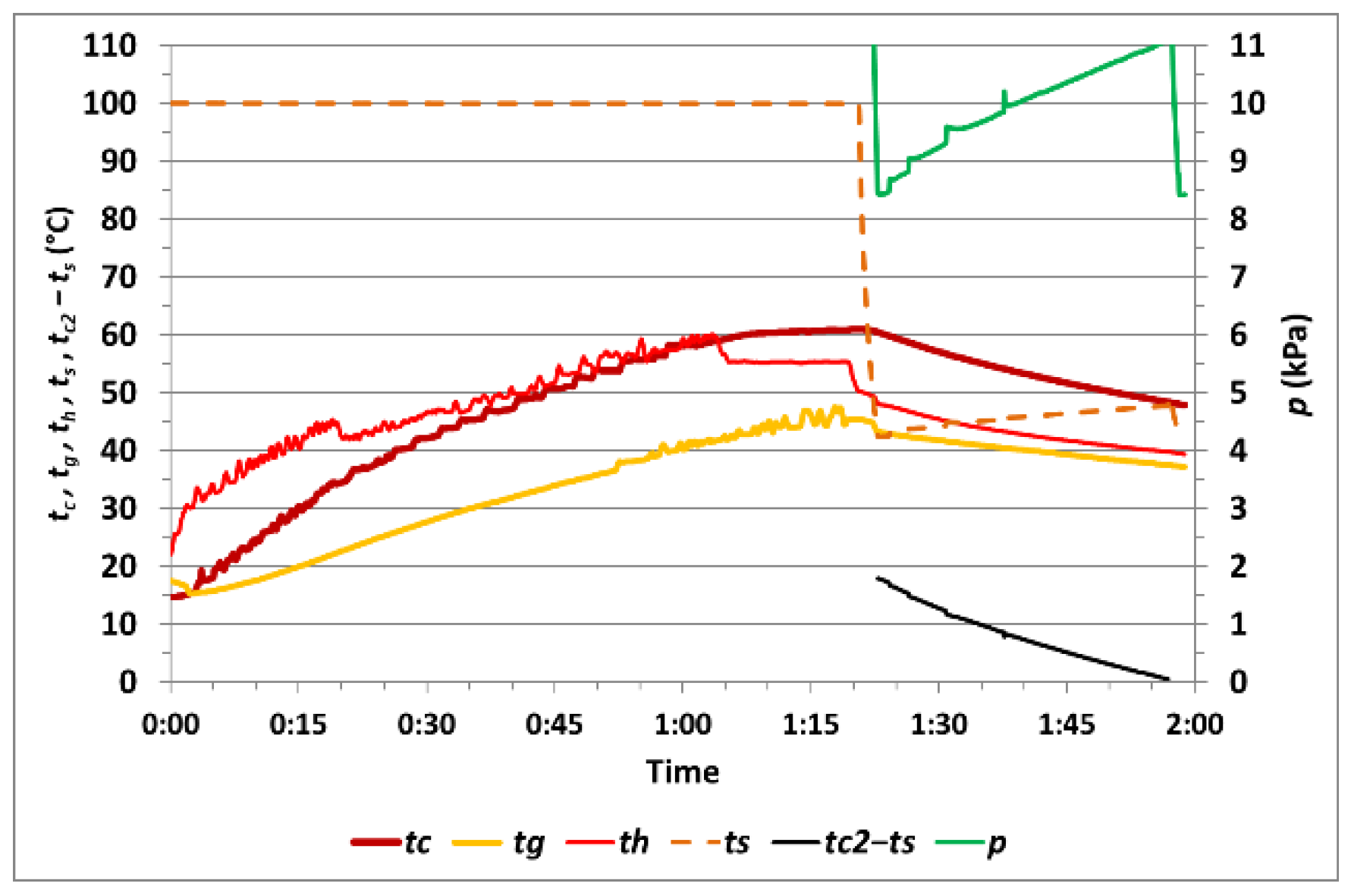



| Measurement No. | p1 | tc1max tc2max | pavg | tc avg | tc2min | (tc2–ts)min | τ2 | mc1 | mc2 | mc3 |
|---|---|---|---|---|---|---|---|---|---|---|
| (kPa) | (°C) | (kPa) | (°C) | (°C) | (°C) | (h:min) | (g) | (g) | (g) | |
| 1 | 100.76 | 55.2 | 5.82 | 45.6 | 38.8 | 1.9 | 1:06 | 1300.00 | 1293.78 | 1292.70 |
| 2 | 102.77 | 50.9 | 5.91 | 43.9 | 38.9 | 2.1 | 0:45 | 1300.00 | 1295.00 | 1293.93 |
| 3 | 102.45 | 52.7 | 6.62 | 44.9 | 39.1 | 2.3 | 0:54 | 1300.00 | 1294.80 | 1293.65 |
| 4 | 101.95 | 60.3 | 9.19 | 52.4 | 46.9 | 1.7 | 0:37 | 1300.00 | 1292.82 | 1291.60 |
| 5 | 101.66 | 60.6 | 9.81 | 53.8 | 48.4 | 0.6 | 0:34 | 1300.00 | 1292.00 | 1290.45 |
| 6 | 101.28 | 59.8 | 9.51 | 53.8 | 48.8 | 3.0 | 0:33 | 1300.00 | 1291.49 | 1290.20 |
| 7 | 102.06 | 61.6 | 9.35 | 61.6 | 62.7 | 17.6 | 0:57 | 1300.00 | 1294.20 | 1293.00 |
| 8 | 101.95 | 62.6 | 9.26 | 61.5 | 60.2 | 15.6 | 0:56 | 1300.00 | 1290.36 | 1289.29 |
| 9 over 2 cycles | 101.93 | 60.5 | 8.66 | 54.1 | 48.6 | 4.6 | 1:26 | 1300.00 | 1282.93 | 1281.80 |
| 9 in 1st cycle | 101.93 | 60.5 | 9.02 | 54.0 | 48.7 | 3.6 | 0:40 | 1300.00 | 1289.80 | 1289.80 |
| 9 in 2nd cycle | 101.69 | 60.4 | 8.31 | 54.1 | 48.6 | 5.5 | 0:46 | 1289.80 | 1282.86 | 1281.80 |
| 10 | 100.74 | 60.0 | 9.74 | 54.2 | 48.7 | 2.6 | 0:48 | 1300.00 | 1295.00 | 1294.10 |
| 11 | 9.90 | 44.7/61.4 | 9.70 | 55.2 | 48.5 | 2.2 | 1:29 | 1300.00 | 1297.11 | 1295.90 |
| 12 | 102.08 | 60.0 | 8.41 | 59.5 | 59.5 | 16.9 | 0:28 | 1300.00 | 1296.86 | 1295.80 |
| 13 | 101.95 | 60.5 | 9.42 | 60.7 | 59.6 | 14.2 | 0:42 | 1300.00 | 1295.80 | 1294.80 |
| 14 | 100.00 | 60.1 | 8.73 | 61.0 | 62.8 | 18.2 | 0:58 | 1300.00 | 1295.90 | 1294.70 |
| Conditions for Determining the Metrological Accuracy of the Hygrometer | |
|---|---|
| Pre-drying temperature (°C) | 60 ± 1 |
| Pre-drying time (min) | 360 |
| Sample weight (g) | 10 |
| Kernel | whole |
| Drying temperature (°C) | 130 ± 1 |
| Drying time (min) | 240 |
| Sample weight (g) | 5 |
| Kernel | ground |
| Corn Water Content Measurement Period | February 2022 | April 2022 |
|---|---|---|
| Weight of corn sample, mc (g) | 10,000 | 9996 |
| Sample weight after pre-drying (g) | 9800 | 9866 |
| Sample weight before drying (g) | 5000 | 5002 |
| Sample weight after drying (g) | 4567 | 4619 |
| Weight of dry matter in the sample, md (g) | 8951 | 9111 |
| Water content of the corn sample, wc (%) | 10,487 | 8858 |
| Measurement No. | md | wc1 | wc2 | wc3 | Δwc | Δwc rel |
|---|---|---|---|---|---|---|
| (g) | (%) | (%) | (%) | (%) | (%) | |
| 1 | 1163.67 | 10.49 | 10.06 | 9.98 | 0.51 | 4.82 |
| 2 | 1163.67 | 10.49 | 10.14 | 10.07 | 0.42 | 4.00 |
| 3 | 1163.67 | 10.49 | 10.13 | 10.05 | 0.44 | 4.19 |
| 4 | 1163.67 | 10.49 | 9.99 | 9.90 | 0.58 | 5.55 |
| 5 | 1163.67 | 10.49 | 9.93 | 9.82 | 0.66 | 6.32 |
| 6 | 1163.67 | 10.49 | 9.90 | 9.81 | 0.68 | 6.48 |
| 7 | 1163.67 | 10.49 | 10.09 | 10.00 | 0.48 | 4.62 |
| 8 | 1163.67 | 10.49 | 9.82 | 9.74 | 0.74 | 7.09 |
| 9 over 2 cycles | 1163.67 | 10.49 | 9.30 | 9.22 | 1.27 | 12.12 |
| 9 in 1st cycle | 1163.67 | 10.49 | 9.78 | 9.78 | 0.71 | 6.75 |
| 9 in 2nd cycle | 1163.67 | 9.78 | 9.29 | 9.22 | 0.56 | 5.76 |
| 10 | 1184.85 | 8.86 | 8.51 | 8.44 | 0.42 | 4.69 |
| 11 | 1184.85 | 8.86 | 8.65 | 8.57 | 0.29 | 3.26 |
| 12 | 1184.85 | 8.86 | 8.64 | 8.56 | 0.295 | 3.335 |
| 13 | 1184.85 | 8.86 | 8.56 | 8.49 | 0.366 | 4.132 |
| 14 | 1184.85 | 8.86 | 8.57 | 8.48 | 0.373 | 4.212 |
Disclaimer/Publisher’s Note: The statements, opinions and data contained in all publications are solely those of the individual author(s) and contributor(s) and not of MDPI and/or the editor(s). MDPI and/or the editor(s) disclaim responsibility for any injury to people or property resulting from any ideas, methods, instructions or products referred to in the content. |
© 2024 by the authors. Licensee MDPI, Basel, Switzerland. This article is an open access article distributed under the terms and conditions of the Creative Commons Attribution (CC BY) license (https://creativecommons.org/licenses/by/4.0/).
Share and Cite
Šooš, Ľ.; Urban, F.; Čačková, I.; Kolláth, Ľ.; Mlynár, P.; Čačko, V.; Bábics, J. Analysis of Thermodynamic Events Taking Place during Vacuum Drying of Corn. Sustainability 2024, 16, 879. https://doi.org/10.3390/su16020879
Šooš Ľ, Urban F, Čačková I, Kolláth Ľ, Mlynár P, Čačko V, Bábics J. Analysis of Thermodynamic Events Taking Place during Vacuum Drying of Corn. Sustainability. 2024; 16(2):879. https://doi.org/10.3390/su16020879
Chicago/Turabian StyleŠooš, Ľubomír, František Urban, Iveta Čačková, Ľudovít Kolláth, Peter Mlynár, Viliam Čačko, and Jozef Bábics. 2024. "Analysis of Thermodynamic Events Taking Place during Vacuum Drying of Corn" Sustainability 16, no. 2: 879. https://doi.org/10.3390/su16020879
APA StyleŠooš, Ľ., Urban, F., Čačková, I., Kolláth, Ľ., Mlynár, P., Čačko, V., & Bábics, J. (2024). Analysis of Thermodynamic Events Taking Place during Vacuum Drying of Corn. Sustainability, 16(2), 879. https://doi.org/10.3390/su16020879








